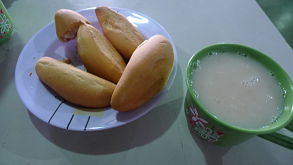Just as happens on ocean passages, on this trip down the river Ucayali from Pucallpa to Iquitos Peru, the days flowed into each other, demarcated only by nightfall and sunrise. So it’s hard now to remember just how long it actually took, but I think it was five days. That’s not counting the day it rained and the cement bag loading had to be postponed, then cancelled. Also not counting the day the officials came aboard late, delaying departure. Or maybe there was another reason, not evident to ‘los gringos’ in Cabin 1. There was a lot of speculation and precious little hard information up in our corner of the passenger deck, and that’s not a bad thing.
Tuky III revealed itself to be 75 meters long, ten meters wide, and no one cares how tall, because there are no bridges to pass beneath. How critical the draft (how deep in the water) would be was revealed almost before breakfast on day one, when we ran hard aground and stayed pressed firmly to a shoal totally invisible in the 2-knot stream of dilute mud that constitutes the Ucayali.
The 440-horsepower Volvo Penta roared to little effect. Out came the depth sounder, a freshly-cut sapling with paint marks every foot of its ten foot length. Then the captain zoomed off in his aluminum skiff. As a result of the visit he made, a passing tug nudged its barge into the shore, tied it to a tree, and came to push us free of the sandbar. I can’t imagine that happening on Delaware Bay!
On we went, doing a do-see-do around the outside of each bend in this very curvy river, then cutting across to the other side. We the gringos ‘navigated’ with an iPhone app, not much detail, but our dot was always in the river. There was no chart of any kind in the wheelhouse, and no electronics other than engine control, light switches and two horns, and some kind of radio we never heard in use. Instead, the appearance of cell phones in many hands was a sure indicator of an approaching settlement.
 |
| Breakfast: sweet watered ?oatmeal? and bread made dry on purpose |
The food bell rang. The passengers gathered their various plastic containers and shuffled before the cook and her ladle. We had misunderstood about bringing dishes and had none, so we were parked at our own little table in front of the TV, which displayed boring old music videos and World Wide Wrestling. The food was well-prepared but it was economy food, obscure cuts of obscure meats flavoring the eternal starch triangle of rice, potato and yuca.
Well, there’s lots more, but the connection is too slow, the line growing behind me, and my patience, frankly wearing thin. And we’re leaving for our ‘jungle excursion’ tomorrow, so I’ll have to hope for time and opportunity to do a better job later on.





